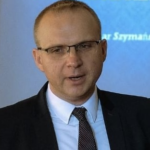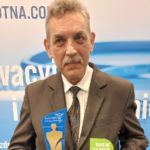
Jarosław Adamek
Construction and expansion of hospital facilities in modular system – Ecological and economic benefits
The main purpose of introducing legislative changes to the „Fit for 55” package is to reduce greenhouse gas emissions by 55%. by 2030 compared to 1990 levels and achieving climate neutrality in 2050. In this context, it is worth noting that all new public buildings have be zero-emission from 2028, and for the remaining ones, the deadline is set for 2030.
Not without significance for the above is the fact that the construction sector is responsible today responsible for approximately 40% of global carbon dioxide emissions. It is assumed that the built-in carbon footprint constitutes 30-40% of the building’s carbon footprint is related to the process of producing building materials and constructing a building. Equally important is the operational carbon footprint of the building, which is a complement to 100%, i.e. 60-70% of the entire carbon footprint of the building. A technical solution that fits perfectly into the EU’s climate policy In Europe, prefabrication is broadly understood, and its share in the construction market is constantly increasing increases. The higher the degree of prefabrication used, the less unfavorable it is the building’s impact on the natural environment. However, if there is a high degree of prefabrication combine with the use of BIM technology for building modeling, it will turn out that we can produce entire buildings in a production plant and deliver them as ready-made elements (3D modules) to the construction site, where only assembly will take place modules and residual finishing works will be performed. This innovative approach to the process of providing construction services allows for quick and above all, trouble-free implementation of investments in the construction of new a also extensions and superstructures of existing specialized buildings, such as facilities for healthcare.

Maurizio Bär
Climate Friendly Hospital Havelhöhe: Transformative action in german healthcare facilities
Maurizio Bär the Sustainability Manager at Gemeinschaftskrankenhaus Havelhöhe, presents a detailed account of the hospital’s transformation into a leading example of climate-resilient healthcare in Germany. He focuses on the specific strategies and actions undertaken at Havelhöhe to incorporate sustainable and climate-friendly processes. This presentation offers insights into the German approach to healthcare sustainability, highlighting the unique challenges and solutions that have emerged during this transformation. At the end of his talk, Maurizio Bär introduces the KliMeG network, emphasizing its role in fostering climate-resilient practices within the German healthcare sector. The talk aims to provide a comprehensive understanding of how German healthcare facilities, particularly Gemeinschaftskrankenhaus Havelhöhe, are adapting to and leading in the area of environmental sustainability.

Artur Białoszewski
Demographic anticipation and its implications for the future of the health system
In the face of rapid demographic changes, such as aging populations, decreasing birth rates and migrations, health systems in Poland around the world are facing new challenges. The presentation focuses on identifying key demographic trends and their potential consequences for the future of health systems, extended by an analysis of the impact of these changes on the demand for health services, resource allocation and public health strategies. Particular attention will be paid to epidemiological, economic and environmental issues related to the adaptation of health systems to changing demographic needs.

Paweł Balsam
„mHealth and telemedicine as tools for cardiology prevention and diagnosis”
Mobile health/mHealth are tools that have become certified medical devices in the last few years. They allow for the diagnosis of many serious cardiac diseases, such as hypertension, diabetes or atrial fibrillation. The main aim of the presentation will be to indicate the possibilities of using new technologies to prevent cardiovascular events, such as heart attacks or strokes.

Adrian Bogusławski
Correct interpretation of the premise of „appropriate systems or standards”environmental management” in public procurement proceedings
The legislator has allowed the possibility of specifying conditions in the procurement process, with regard to technical or professional capacity. In this regard, it is possible to specify conditions related to education, experience, or technical potential. Furthermore, the contracting authority may also require compliance with specific environmental management systems or standards by the contractor. The proper interpretation of this provision is crucial from both the perspective of the contracting authority and the bidder applying for a particular order. When indicating the need for the contractor to meet a specific environmental management standard in the area of technical or professional capacity, the contracting authority must take into account the subject matter of the order. It would be unjustified to demand the presentation of specific systems or standards when the execution of the order, especially its subject matter, does not require compliance with the indicated systems or standards. In the case of a justified need for the contractor to have appropriate environmental management systems or standards, the contracting authority may refer to the eco-management and audit scheme (based on Regulation (EC) No 1221/2009 of the European Parliament and of the Council), but also to other environmental management standards. For this purpose, the contracting authority may require the contractor to provide relevant certificates issued by a certified, accredited entity, demonstrating compliance with the requirements by the contractor.
To meet specific environmental management standards, the contractor, in turn, should not apply expansive interpretations.

Anders Bolmstedt
Healthcare is a very chemical-intensive sector. Cancer-causing, mutagenic, reproductively toxic, corrosive etc. chemicals are used that can harm people and the environment.
In this presentation, we will discuss strategies to reduce the problem of hazardous chemicals in healthcare through sustainable procurement, risk assessments for safe chemical handling, and phase-out plans for hazardous chemicals.

Maria Budnik Szymoniuk
Infusion team – a solution that improves the quality of the procedure and increases the epidemiological and organizational safety of health care facilities
Infusion service is a natural next step in caring for the health of patients and medical staff. It is also a way to reduce the risk of adverse events related to medical care, because the method of conducting infusion therapy affects the final effect of the therapeutic process, and irregularities in this area may cause adverse events requiring expensive treatment. The consequence also seems to be the economization of medical activities. It would be good if the professional competences of health care professionals were used in interdisciplinary activities within the infusion service. The staff of individual departments could then count on help or consultation from the infusion service. It is important that such a service includes, in addition to a nurse, a hospital pharmacist. Irregularities and mistakes in the preparation and administration of medications in hospital wards are nothing more than medical errors that have a real impact on the effectiveness of treatment and the length of hospitalization.

Joanna Cur
Work life balance of health care workers
In 2023, a number of regulations entered into force that will improve the work-life balance of employees. During my speech, I will focus on the analysis of related legal aspects, current regulations regarding working time, rest and flexible forms of employment in the context of the specific work of doctors, nurses, medical staff and office workers.
The legal analysis will include aspects related to remote work, other forms of flexible employment, additional days off and parental rights in the area of health care. I will focus on identifying potential legal challenges related to introducing and maintaining a balance between employees’ professional and private responsibilities, as well as looking for opportunities to adapt work organization to increase work life balance.
In addition, the speech will focus on issues related to employee protection in the context of Work-Life Balance, including the prevention of burnout, the promotion of a healthy work environment and access to psychological support programs for health care workers.
The presentation will aim not only to present the current legal status regarding Work-Life Balance in the health care sector, but also to initiate a discussion on possible further legislative changes and corporate practices that may help improve the work-life balance of employees in this key social area.

Anna Fuster Muñoz
Towards circularity – achievements and challenges
Environmental sustainability manager at Consorci Hospitalari de Vic and Consorci de Salut and Social de Catalunya, Anna Fuster Muñoz, presents Consorci Hospitalari de Vic’s path towards a circular economy, as well as the related achievements and challenges, including in the areas of energy self-sufficiency, water savings, waste reduction. One of the key points of the action plan is the reduction of plastic and single-use products. The presentation will show examples that can be an inspiration for other hospitals.

Maria Gaden
Circular economy in clinical settings
In Center for Sustainable Hospitals sustainability in healthcare is approached in a broad perspective, focusing on the transition towards Circular Economy. This is done through a number of clinical projects, where the challenges and potentials linked to both clinical behaviour, products, guidelines, legal framework and organisational culture is analysed, tested and implemented. Maria will focus on examples, successes and challenges, and reflections upon what kind of approach, leadership and organisational structures a local transformation of a healthcare needs.

Małgorzata Gałązka-Sobotka
Value-driven health care
Highly developed countries, faced with growing epidemiological and demographic threats on the one hand, and growing cost pressure on the other, are looking for more effective and efficient models of health care organization. Recent decades have shown a limited potential for a systematic increase in expenditure without linking investments in health with actions directly leading to improvement in the effectiveness, safety, equality, accessibility or efficiency of processes implemented in the health care sector. The answer to the need to increase the efficiency of health care systems is the Value Based Healthcare concept, initiated in Great Britain and developed in the USA, which is implemented by numerous European countries, with the Netherlands and Denmark at the forefront. The key assumption of a health value-oriented system is to focus on values important to the patient, i.e. the effects of treatment and the experience of using diagnostics and treatment, which affect the quality of life. For care providers, the key parameter in assessing their activities should be to maximize the ratio of the treatment result to the cost per patient, while maintaining sensitivity to the risk of social inequalities. The components of a system highly oriented towards creating health value are: digital data systems that facilitate their analysis, systems for measuring costs and treatment results, benchmarking, integrated care paths, models of paying for health value and not the service itself, public procurement oriented on health value and a network of suppliers guaranteeing its maximization, and not only price minimization. The foundation of the system is cooperation, communication, measurement and transparency.

Paweł Gambal
The importance and development of primary care and specialty care on the example of the Polkowice Health Services Center
Paweł Gambal, director of PCUZ, describes how primary and specialized health care works at the Polkowice Health Services Center, where turnover has increased by nearly 100% in three years, and the clinic admits nearly 200,000 patients annually, in a commune with a population of 25,000. The statistics of patient admissions in primary care and emergency care are described, along with their impact on financial results in 2020-2023 and the changes that were made during this time, both in the administrative, technical and equipment, human resources, marketing and medical areas. In addition, development plans for the future are described.

Akif Görgülü
How we help transform healthcare into a more climate-friendly one
Akif will present the Global Greens and Healthy Hospitals engagement network for healthcare providers, managed by HCWH Europe, and his organisation’s efforts towards a PVC-free healthcare sector.GGHH creates a sustainable healthcare sector. One that does no harm to patients or our planet. One that acts as a catalyst, inspiring action right across society to protect human health and the environment. One that drives change in communities, so people can live more healthily on a healthier planet.

Dorota Halicka
Reporting in accordance with the requirements of the CSRD Directive. ESG standards as the basis for sustainable development in green management hospital. Practical workshops
At the beginning of January 2023, the EU CRSD directive entered into force, introducing new regulations in sustainable development reporting. Many companies will be obliged to report on their ESG activities. ESG reporting, also known as CSR reporting (sustainable development, non-financial), covers the disclosure of information about the company’s management of environmental, social and corporate governance factors. Therefore, you should be interested in the issue of creating reports well in advance to be able to familiarize yourself with the requirements, plan the document and implement the ESG strategy. Knowledge of the 12 ESRS standards that prepare for sustainable management of a medical facility will also be helpful. The obligation to report ESG will sooner or later apply to every organization and every hospital, so it is worth getting interested in it now. Organizations that are required to report in accordance with ESG criteria will pay attention to their entire supply chain and expect from other organizations with which they cooperate detailed information regarding the origin of the service, carbon footprint or a list of environmental aspects that have a negative impact on the environment in the business they run. activities.

Zbigniew Hupało
„If you want to change the world, start with yourself” Mahatma Gandhi. Hospital in Gostyń – at the beginning of the road
The hospital in Gostyń is only at the beginning of the „green” road. However, similarly to other similar facilities, projects related to the green transformation have been undertaken for years – successive replacement of devices with energy-saving ones, waste segregation, digitization of documents and a number of others. We continue these activities and plan new ventures.
We see environmental safety much more broadly. We are implementing new solutions, such as a closed cannula system, which will reduce the amount of materials used while increasing comfort and epidemiological safety.
We are planning many investments, including the largest – expansion of the hospital in a modular system with the so-called passive buildings. The implementation of these projects requires the cooperation of many parties – international entities, Polish public institutions, the world of science. Such strictness is a guarantee of their success.

Kamil Janeczek
How to reduce the negative impact of inhalers on the environment?
The healthcare sector is responsible for 5-8% of global greenhouse gas emissions. Among the many elements contributing to this value, inhalers used by patients with asthma and COPD occupy an important place. Over 630 million pieces of pressurized metering inhalers are used annually around the world, which results in a carbon dioxide burden of approximately 13 million tons/year. During the lecture, actions to reduce the adverse impact of inhalers on the environment will be discussed, both at the level of inhaler and drug manufacturers, as well as and medical staff and the patients themselves.

Andrzej Jeżyk
„Sustainable investments – from idea to implementation”
The hospital in Wolica cares not only about the treatment of patients, but also about the environment and the well-being of employees. We will focus on the balance between economic, social and environmental aspects, while ensuring the quality of the services provided. We promote healthy and safe working conditions. We engage in social activities for health prevention, promoting the idea of „Green Hospitals” in Poland and around the world.
Sustainable hospital investment refers to making investment decisions that simultaneously take into account financial, social and environmental aspects. It is important to maintain logic and consistency in action to achieve the best possible results. Reducing energy consumption translates into less air pollution, but also into lower operating costs of the hospital. Own heat and energy generation sources make the hospital largely independent of the increase in prices of these media.
They contribute to reducing the risk of energy failures, which is crucial for maintaining the operational continuity of the hospital, ensuring the safety of patients and employees, as well as minimizing potential financial losses. Optimizing the operation of systems, reducing energy and water consumption, reducing and improving the quality of wastewater bring many benefits both to the environment and to hospital users and the local community. Hospital digitization and cybersecurity also play a key role.
The Technical and Operational Department is responsible for maintaining the technical infrastructure of the Hospital, planning and implementing new investments, as well as the pro-environmental policy of the facility. We start the investment process by identifying needs. The investment picture emerges from the market analysis and comparison of the benefits and costs of the project. The resulting project card, business plan or application for an opinion on the advisability of the investment allows you to indicate the scope of the project, its goal and priorities, as well as submit applications for external funds to finance the task. If funds are obtained, we proceed to the implementation of the investment, and after its completion – to monitor the effects.
Over the last few years, the hospital has completed a number of investments implementing ESG assumptions, including:
Construction of a modular pavilion, including: for post-COVID-19 patients and a connector integrating the pavilion with the main hospital building (2021-2023) Photovoltaic farm with a capacity of 200 kWp (2022) Installation of heat pumps securing a second heating source. and domestic hot water (2023) Liquidation of the coal boiler room – replacement of the furnace with gas boilers (2004) Through our activities and promotion of the idea of Green Hospitals, we want to encourage people responsible for maintaining health care facilities to implement sustainable development strategies.
We argue that ecological education is also health prevention. Environmental protection has become an important element of public health protection and requires the creation of tools that will allow health to be taken into account in various decisions, plans, policies and investments.

Agnieszka Kubiszyn
EU GPP criteria for equipment electrical and electronic equipment used in the healthcare sector.
Green public procurement (GPP) is defined in the Communication „Public Procurement for a Better Environment” (COM-2008-400) as „a process whereby public authorities seek to procure goods, services and activities with reduced environmental impacts compared to goods, services and activities with the same primary function that would otherwise be procured.” In Poland, according to the report of the President of the Public Procurement Office on the functioning of the public procurement system for 2022, the share of green procurement in the total number of contracts awarded was only 2%. The ambitious goals set by the European Union have led to the development of common criteria for green procurement usable in EU member states. The criteria were developed for those product groups that were deemed most suitable for GPP implementation both in terms of procurement value and environmental impact. This presentation discusses EU green procurement criteria for electrical and electronic equipment used in the healthcare sector.

Waldemar Machała
General anesthesia – poisoner or savior?
General anesthesia is one of the most common anesthesia techniques performed on patients to enable surgery. To achieve this goal, it is necessary to use sleep-inducing drugs, muscle relaxants and pain-relieving drugs. Sleep can be induced using, among others: drugs administered to the patient’s lungs. These are currently used alternatively: sevoflurane, desflurane or isoflurane. In addition to inducing sleep, these drugs (inhalational anesthetics) have beneficial organ effects; therefore, they serve what is sometimes referred to as activities that ensure the well-being of the patient.
Over the last few years, there has been an ongoing discussion about the impact of gas emissions on the cleanliness of the planet (in the broad sense of the word). Its consequence was the recognition that some chemical preparations (unfortunately, inhaled anesthetics) were considered particularly harmful to the atmosphere, which led to the regulations introduced – ordering their withdrawal from use.
“Should we throw the baby out with the bath water…?”

Justyna Malińska
The importance of green procurement on the public procurement market (including as part of EU projects)
Green public procurement – GPP are a process by which public institutions strive to obtain goods, services and construction works that have a lower environmental impact during their life cycle compared to goods, services and construction works with an identical purpose that would otherwise be procured.
Green public procurement can provide financial savings for public authorities – especially when taking into account the costs of procured products or services throughout their life cycle, and not just in terms of purchase price.
In order to increase the effectiveness of the public procurement system and maintain the expediency of spending funds before initiating the procurement procedure, an analysis of the needs and requirements related to a given project is performed – a new obligation introduced in the Public Procurement Law. This issue is regulated by Art. 83 PZP.
The analysis includes in particular:
– examining the possibilities of meeting identified needs using own resources and
– market research in terms of alternative means of meeting identified needs, as well as possible variants of order fulfillment, or indicates that there is only one possibility of fulfilling the order.
Green public procurement can therefore be a tool for shaping new standards in the field of products or services provided on the market, as well as being a determinant for producers in terms of the goods, technologies and innovations they create.
Authorities that implement green public procurement will be better equipped to meet evolving environmental challenges, as well as to achieve political and binding targets for reducing CO2 emissions and increasing energy efficiency and in other areas of environmental policy.

Marta Moles
Institutional approach to healthcare sustainability: environmental, social and governance perspectives
In her presentation, Marta Moles, sustainability manager at the Health and Social Care Consortium of Catalonia (CSC), refers to the activities that are undertaken in health and social care entities associated with the organization to promote sustainable development from a triple perspective (environmental, social and management). It will also present best practices implemented in the institution that contribute to achieving the United Nations Sustainable Development Goals.

Dorota Napierska
Safe and sustainable use of plastics – challenges and opportunities for the healthcare sector
Our current unsustainable production and consumption patterns create constant demand for primary raw materials, cause endless amounts of waste, and put huge pressure on our planet.
Scientists concluded that the rapid growth of chemicals and plastic production has already exceeded a planetary boundary. Plastic production has doubled in 20 years and at current rates could triple by 2060 without action. Current use of plastics and plastic products is often neither safe nor sustainable, with high rates of single-use items and a low rate of reuse and recycling back into the economy. The human dependence on plastics in everyday life is reflected in their ubiquitous presence as litter in the environment. Products made of plastics are a well-known source of a mixture of chemicals that may eventually end up in the human body. Some of these chemicals have hazardous properties and are known to impact our health; the toxicity of many other chemicals is either not completely characterised or just unknown. Use of recycled plastics creates potentially new pathways through which humans can be exposed to hazardous chemicals in contaminated materials. And there are emerging concerns related to microplastics because of their widespread presence and the potential physical and toxicological risks they pose to organisms.
The market of plastic medical devices and pharmaceutical packaging continues to grow. A key benefit in healthcare – versatility of plastics combined with a low cost – has enabled the mass production of single-use healthcare products that are both functional and hygienic. However, the current dominant healthcare “throwaway” policy is a significant source of pollution. Also, plastics used in the healthcare sector regularly contain harmful chemicals and can therefore pose a direct risk to patients and staff.
The presentation will address both general issues related to the safe and sustainable use of plastics, as well as the healthcare sector’s emerging need for action and ability to address the challenges posed by this material.

Justyna Król-Całkowska
Legal aspects of the use of AI in health care – concepts of liability a slave and an animal. Practical workshops
The speech presents the possibilities of using artificial intelligence during qualification for treatment, monitoring of chronic diseases, as well as the diagnostic and therapeutic process. The presentation will present the differences between AI in the strict sense and intelligent systems that are mistakenly identified with AI. The main goal is to indicate who and to what extent is responsible for the activities of artificial intelligence. Particular attention will be paid to issues related to the concept of responsibility – „as for a slave” and as for an animal. At the same time, situations in which liability will not arise due to „AI insanity” will be analyzed.
Refusal to issue medical documentation in the form of a paper copy or printout – violation of patient rights or action to protect health?
During the speech, the benefits of keeping documentation in electronic form will be analyzed, with particular emphasis on those related to its sharing, as well as those that reduce the consumption of fixed assets. We will find the answer to the question whether the refusal to issue documentation in the form of a printout or a copy constitutes a violation of the patient’s rights, or even a strange action to protect his rights, including the right to health and life in a non-hazardous environment. How to limit the issuance of documentation in paper form? Is it possible to regulate these issues in the regulations of the healthcare entity? When does a patient have an absolute right to paper documentation?
Excessive prescription-the context of reimbursement and the risk associated with obviously unnecessary therapy
Does excessive prescription pose a threat to the patient and the environment and when? Analysis of a rarely discussed issue – does excessive prescription, including antibiotics and medicines available free of charge for seniors, people under 18 years of age and pregnant women, only constitute a threat to patients’ health or also a threat to the environment? The presentation will address issues related to the risks associated with excessive prescription in the context of liability for exposing the patient to the risk of health loss, as well as environmental risks due to an unjustified increase in supply, incorrect segregation and disposal of unused medicinal products, taking expired products and the effects of such actions.
Telemedicine and telecare as an alternative form of providing health services in AOS. How does the elimination of personal doctor-patient relationships increase the effectiveness of treatment and protect the environment? Practical workshops.
Legal basis for providing health services and limitations in this regard. What is the liability of medical entities for the negative effects of health services provided remotely? How large are the operational savings associated with abandoning the classic formula of providing health services? Are teleservices effective and safe for the patient and why? Do Co2 emissions decrease when providing telemedicine services? Is the quality of services only about certification and accreditation, or also about real benefits for the environment?

Elaine Mead
The implications of healthcare quality improvement and environmental protection
The delivery of healthcare is a complex business which has had a hugely positive impact on the quality and length of life, through the adoption of new practices, drugs, and technologies.
However, it can be wasteful of resources and, in its current form, is now recognised as having a detrimental impact on planetary as well as population health. To move to services that contribute less to this problem, there must be a wider understanding and acceptance of this issue amongst healthcare leaders and staff, and rapid change to reduce the consequences on global health. Across the UK and Europe, there are excellent examples of individual projects that have reduced the carbon footprint of healthcare in many settings led by committed individuals.
However, current literature confirms a lack of evidence of the adoption of a systematic methodology to routinely incorporate this issue, or engaging and maximising the expertise of healthcare staff as trusted ambassadors and agents for change.
This presentation will explore the adoption of a continuous improvement philosophy and method in healthcare as a vehicle for addressing the removal of waste from clinical and administrative processes and supply chains, to deliver healthcare that can be sustainable for future generations.

Katia Pacella
Katia Pacella Plastics and Human Health
The production and use of plastic has increased significantly since 1960, with a growing body of evidence highlighting the human health impacts of plastic chemical exposure. More than 13,000 chemicals are associated with plastics across a wide range of applications. Of these, over 3,200 monomers, additives, processing aids and non-intentionally added substances are of potential concern. Some chemicals are particularly concerning due to their known toxicity and potential to leach from plastic products, including healthcare items and food packaging, into the environment and human bodies.
The Minderoo-Monaco Commission on Plastics and Human Health explores the impact of plastic-associated chemicals on our health. Plastic additives disrupt endocrine function, increasing the risk of infertility, obesity, cardiovascular disease, renal disease, and cancers. Infants and young children are particularly vulnerable, facing risks of prematurity, birth defects, impaired neurodevelopment, and childhood cancer.
The Minderoo Foundation’s presentation will discuss the impact of plastics-associated chemicals on human health and share its vision on a way forward to reduce chemical exposure to all plastics and protect the most vulnerable groups of people.

Monika Raulinajtys-Grzybek
GRI indicators and their application in relation to medical facilities
GRI indicators present the organization’s involvement in areas of social responsibility. The use of measurable values allows you to operationalize the approach and present the impact that the organization has in the ecological, social and corporate governance areas. Individual indicators concern the areas that are reported, while the selection of a specific indicator depends on the reporting organization. The impact of different industries on ESG aspects is different, which is why in recent years, efforts have been made to develop a set of industry indicators. For health protection, such a set has not yet been developed. The aim of the speech is to present exemplary indicators reported by medical entities and discuss the information gap between the current structure of GRI indicators and the specificity of the medical industry.
ORCID 0000-0002-2451-8061

Małgorzata Sieradzka
Green public procurement as an element of the state purchasing policy
Green public procurement (GPP) is a process by which public institutions seek to obtain goods, services and construction works that have a lower environmental impact during their life cycle compared to goods, services and construction works with an identical purpose that would have been ordered otherwise. Green public procurement is primarily about savings, but due to the fact that the costs of the product life cycle are taken into account. Therefore, sustainable procurement is promoted in public procurement. The state purchasing policy for 2022-2025 is intended to contribute to sustainable and innovative procurement.
Green procurement for the purchase of medical equipment and supplies – are there any recommendations?
Green procurement for the purchase of medical equipment and technologies requires the preparation of appropriate environmental, social and innovative criteria. The above means promoting circularity. Environmental criteria for evaluating offers will enable the customer to meet the needs of the ordering party, taking into account environmental protection. Proper preparation of the public procurement procedure will allow ecology to be taken into account to the maximum extent. A very important aspect is also constant cooperation with contractors and other participants of the public procurement market in pursuit of achieving environmental goals.

Maciej Stawny
Infusion team – a solution that improves the quality of the procedure and increases the epidemiological and organizational safety of health care facilities
Infusion service is a natural next step in caring for the health of patients and medical staff. It is also a way to reduce the risk of adverse events related to medical care, because the method of conducting infusion therapy affects the final effect of the therapeutic process, and irregularities in this area may cause adverse events requiring expensive treatment. The consequence also seems to be the economization of medical activities. It would be good if the professional competences of health care professionals were used in interdisciplinary activities within the infusion service. The staff of individual departments could then count on help or consultation from the infusion service. It is important that such a service includes, in addition to a nurse, a hospital pharmacist. Irregularities and mistakes in the preparation and administration of medications in hospital wards are nothing more than medical errors that have a real impact on the effectiveness of treatment and the length of hospitalization.

Waldemar Szymański
Criminal law aspects of combating cybercrime and abuse of electronic communications
During the speech, provisions penalizing violations of information security, ICT data and data constituting business and professional information will be presented. In addition, the most common violations in electronic communications, such as spoofing or smishing, will be discussed. The main aim of the speech will be to present the modus operandi of cybercriminals. A very important aspect of the presentation will be education on how to minimize threats to avoid becoming victims of cybercriminals.
Blocking access to IT data by encrypting them on the servers of medical entities – criminal law consequences
Encryption of IT data on the servers of medical entities with malicious software „ransomware”, combined with the demand for financial benefits for restricting access, are attacks that result in a threat to the life and health of patients. The speech will discuss criminal provisions penalizing the actions of perpetrators and the essence of malware attacks. Issues related to the specific types of demands for financial benefits and the consequences of their possible implementation in exchange for restoring access will also be discussed.

Monika Wałachowska
New technologies in medicine and patient rights. Chances and dangers
During the speech, the advantages and disadvantages of new technologies used in medicine will be indicated, in the context of the need to protect patient rights (also in the case when the use of technology has been abandoned). In my speech, I will refer to practical examples and the issue of liability for violating patient rights in connection with the (non)application of new technologies in medicine. These issues are particularly important when it comes to the patient’s right to information and the right to services that meet the standards of current knowledge medical.

Sławomir Wysocki
Green transformation of Provincial Specialist Complex of Health Care Centers for Lung Diseases and Tuberculosis in Wolica
The Hospital for Lung Diseases and Tuberculosis in Wolica is the first hospital in Poland that joined the Global Green and Healthy Hospitals global network of green hospitals and started measuring its carbon dioxide emissions and, above all, its reduction. Thanks to the planned investment strategy in green solutions, the hospital has become a leader in sustainable development, which is confirmed by numerous awards, including the most important Health Care Climate Champions awarded by GGHH. Hospital director Sławomir Wysocki presents the investments and activities undertaken to lead the hospital to climate neutrality.

Michalis Zouloufos
Climate crisis and managing hospitals
Hospital CEOs often work like circus jugglers. The overall hospital operation is on their hands and managing skills, according to the traditional framework. However, climate crisis and its worldwide effects put an extra operational load on hospital operation. In the aftermath of the COVID-19 pandemic and the ever-present climate crisis, the new hospital management challenges are investigated on both organizational and CEO levels. The presentation is aimed primarily to Hospital CEOs, Sustainability Managers and those involved into hospital strategic operational planning.
